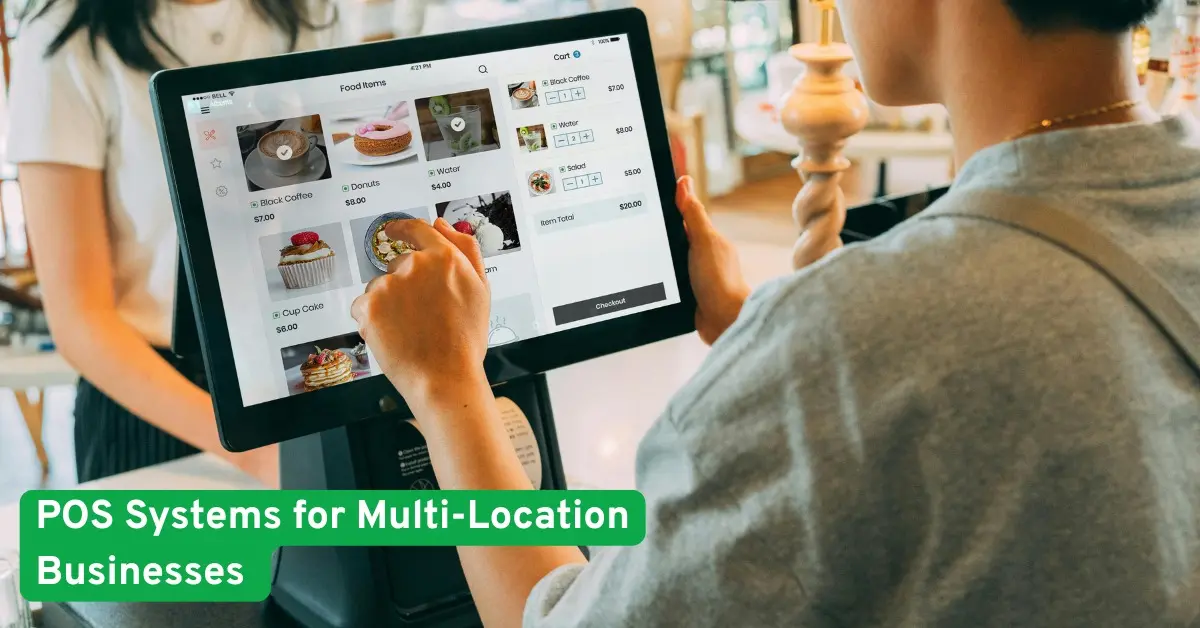
Multi-location businesses need a POS that centralizes products, inventory, pricing, and reporting while staying resilient at the store level. The winning stack offers real-time sync with offline failsafe, role-based controls, region-aware tax and promo engines, unified customer profiles, and open APIs for eCommerce, delivery, and accounting. Implementation success depends on a phased rollout, clean data migration, and crystal-clear SOPs for inventory, pricing, and permissions.
1.Why Multi-Location POS Is Different
Running two or twenty stores is not just “more of the same.” You have:
Shared catalog but local variations in price, tax, and availability
- Inventory spread across stores and a warehouse with transfers and holds
- Staff roles that differ by store and region
- Promotions that need central rules yet local overrides
- Online and delivery channels that must reflect real inventory in every location
- Executive reporting that rolls up cleanly without exporting to spreadsheets
- Traditional single-store POS tools break here. You need a platform designed for multi-store scale from day one.
2.Core Capabilities You Really Need
Central Control
- Master product catalog with variants and modifiers
- Global and per-store price lists
- Centralized promotions with location scoping
- Company-wide customer profiles and loyalty
Local Resilience
- Offline mode at the register with auto-sync
- Local printers, cash drawers, and kitchen display systems
- Store-level permissions and cash management
Multi-Location Inventory
- Real-time counts by store, warehouse, and channel
- Transfers, cycle counts, wastage, damaged, returns
- Purchase orders and vendor management
Operations
- Role-based access control with approval workflows
- Employee time tracking and performance dashboards
- SOPs embedded as guided flows at checkout and receiving
3.Architecture That Actually Scales
Recommended model
- Cloud control plane for master data, analytics, and APIs
- Lightweight store clients for POS stations and KDS
- Real-time event streaming for inventory, orders, and payments
- Offline first at the edge with conflict resolution on re-sync
Why this works
- Central data stays authoritative
- Stores continue selling during internet blips
- Event logs create an auditable trail for finance and ops
- You can add locations without re-architecting
4.Inventory, Pricing, and Promotions Without Chaos
Inventory
- Treat each location as a stock node
- Use demand-driven POs with min-max thresholds
- Enforce receiving workflows with barcode checks
- Use transfer requests with in-transit tracking
Pricing
- Maintain a global price book plus store-specific overrides
- Schedule price changes and map to promotional calendars
- Track margin impact by product, category, and store
Promotions
- Rules engine with conditions: location, time, basket mix, customer tags
- Stacking logic and priority to prevent discount abuse
- Auto-end promos and instant rollback if performance dips
5.Payments, Tax, and Compliance
Payments
- EMV chip and contactless
- Split payments, tips, surcharges where legal
- Tokenization for returns and recurring charges
Tax
- Location-aware tax profiles
- Product-level tax flags and exemptions
- End-to-end audit logs for filings
Compliance and Security
- PCI DSS scope reduction through validated terminals
- Role-based permissions and audit trails
- Data retention and regional privacy rules
6.Analytics That Leaders Can Trust
Dashboards by role
- Exec: sales, gross margin, promo ROI, store leaderboard, inventory turns
- Ops: out-of-stocks, shrinkage, receiving accuracy, transfer SLAs
- Marketing: coupon conversion, CLV, cohort retention
- Store: hourly sales, top sellers, labor vs sales
Report hygiene
- Single source of truth from the cloud control plane
- Frozen month-end snapshots for finance
- Export-free workflows through filters and saved views
7.Integrations That Remove Manual Work
- eCommerce: live inventory by store, local pickup, ship-from-store
- Delivery: menu sync, order injection, and status webhooks
- Accounting: daily journal entries, COGS, tax liability, and payouts
- Loyalty and CRM: unified customer profiles across channels
- Procurement: vendor catalogs and EDI where available
- Open, well-documented APIs are essential. Avoid closed systems that trap your data.
8.Rollout Plan and Change Management
Phase 0: Readiness
- Clean product data, barcodes, and units
- Map roles and approvals
- Document SOPs for receiving, cash, discounts, and returns
Phase 1: Pilot Location
- Parallel run for one full inventory cycle
- Reconcile daily to catch mapping or tax issues
- Collect frontline feedback and refine SOPs
Phase 2: Wave Rollouts
- Train champions at each store
- Migrate in waves by region
- Monitor KPIs and hold a rollback plan
Phase 3: Optimization
- Tune price and promo rules
- Introduce advanced reporting and labor optimization
- Automate replenishment from warehouse to store
9.Cost Model and ROI Snapshot
Costs
- Software licenses per register or per location
- Hardware terminals, scanners, printers, KDS
- Payment processing fees and terminals
- Implementation, training, and support
- Optional integrations and custom API work
ROI drivers
- Fewer stock-outs and faster inventory turns
- Reduced shrink through permissions and audit logs
- Labor efficiency with faster checkout and guided SOPs
- Higher promo ROI through better targeting and controls
- Reliable multi-channel sales without overselling
10.KPIs to Track From Day One
- Sales per labor hour
- Gross margin by store and category
- Inventory turns and days of supply
- Stock-out rate and shrinkage
- Promo lift and discount leakage
- Average order value and item attachment
- Customer repeat rate and CLV
- Refund rate and reasons
- Order fulfillment SLA for pickup and delivery
11.RFP Checklist
Use this list when evaluating vendors.
Platform
- Central catalog, price books, and promotions
- Multi-location inventory with transfers and PO
- Offline mode with conflict resolution
Operations and Security
- Role-based access with approvals
- PCI scope reduction and audit trails
- Region-aware tax engine
Analytics
- Role-specific dashboards and scheduled reports
- Month-end snapshotting and export controls
Integrations
- eCommerce, delivery, accounting, loyalty, and procurement
- Public APIs with webhooks and sandbox access
Support
- Implementation plan, training library, SLAs, and success manager
- Clear roadmap and release notes
12.FAQs
Q1: How does a multi-location POS keep inventory accurate across stores?
By treating each store and the warehouse as separate nodes, syncing movements in real time, and enforcing SOPs for receiving, transfers, adjustments, and cycle counts. Event logs make every change auditable.
Q2: What happens if the internet drops at a store?
Registers continue in offline mode, queue events locally, and re-sync automatically. Conflict rules prioritize the control plane while preserving valid local sales.
Q3: How can I prevent discount abuse across locations?
Use a rules engine with role-based overrides, approval prompts for manual discounts, and reports on discount leakage by cashier and store.
Q4: How do online orders avoid overselling?
Expose per-store inventory to eCommerce and delivery partners and reserve stock at order creation. Support ship-from-store and pickup with cutoffs.
Q5: Can pricing differ by region without duplicating the catalog?
Yes. Keep one master catalog and attach regional price lists and promotions as layers. Schedule changes and test on a sandbox location first.
13.Implementation with US Payrun
If you are considering US Payrun for multi-location operations, align your rollout to these best practices:
Centralize catalog, price books, and promotions
- Configure store-level tax and payment profiles
- Enable inventory nodes for each store and the warehouse
- Connect eCommerce or delivery channels to the live inventory API
- Define role-based permissions and discount approvals
- Build dashboards for exec, ops, marketing, and store managers
- Train store champions and run a two-week pilot before scaling
